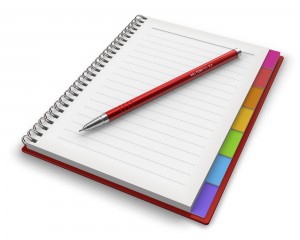Tips for Using Your Planner Effectively

Do entrepreneurs need planners? You’re not really asking me that are you? Regardless of whether you use a paper or an electronic planner, there are several aspects that you need to attend to if you want to your entrepreneurial life (and the rest of your life) peacefully and predictably productive. Here are this week’s top ten productivity tips for using your planner effectively:
- Block time for re-entry. If you have been out of the office (and/or home), you need time to “re-enter” or “re-cover.” Whenever you are planning a business trip, a vacation, or surgery, block out time on your planner for “re-entry.” This allows you to process the email, voice mail, and paperwork that have accumulated during your absence.
- Use a month-at-a-glance calendar or view. Any good planner is going to give you a way of seeing your month at a glance. This feature gives you a “storyboard” of your month. You can be more productive by making sure that the month itself is reasonably balanced, even if particular days or weeks are not.
- Use a week-at-a-glance calendar or view. Depending on your position, you may need to also have a week at a glance so you know what is in the offing for the week. Most planners offer this feature as one of the options and some of them design their whole system around the weekly calendar, (e.g., Planner Pad).
- Schedule time to answer emails and voice mails. If you try to do a “catch as catch can” approach to handling emails and voice mails, you’re always feeling chaotic. So schedule 30 minutes, 60 minutes, or whatever number of minutes you need to once or twice a day and handle the electronic messages that you need to. The key here is “schedule” that time. And did you catch that I said “once or twice a day?”
- Schedule project time. Essentially all entrepreneurs have projects to work on as part of their business life. We imagine that we will work on that project ‘as we have a chance.’ Good grief. Doesn’t work too well, does it? Projects are part of your business, so schedule time to work on those project just like you’d schedule a meeting or some other type of appointment. And then keep that scheduled time sacrosanct.
- Keep a running list of tasks in your planner. David Allen, author of Getting Things Done (The Art of Stress Free Productivity), recommends that these tasks be divided up by what type of tasks (e.g., phone, at computer, errands, etc.) Regardless of whether you follow that advice, do keep a list of things that you need to do in your planner. It’s a great place to capture the idea and then you can always refer to your planner to see what else you need to/could be working on.
- Make notes during meetings or other appointments or while standing at the grocery store. There’s no sense in trying to “remember” what was said. Write it down. If you never need it, then no big deal, but if you do, it’s captured and you have a written record of what was said, decided, etc. When I was in graduate school, every time I went to the student loan office, I would write down what was said and then I’d have the person who said it put his/her initials next to it (can you tell that I’d been told one thing one time and something else another time).
- Consider the OATS strategy for planning. O = Objectives, A = Activities (that will lead to the completion of those objectives, T = Time (needed to complete the activities), and S = Schedule (the time needed). If you create a few sheets like this and keep them in your planner (or create a template to use in your smartphone), then you can think through various projects and other responsibilities in a deliberate and strategic way. Once you’ve done the thinking, then you’re ready to use your planner to bring the project to fruition (in a non-chaotic fashion).
- Empty your psychic RAM (David Allen’s term). You need to have index cards, blank pieces of paper, or little pads where you can write down ideas that come to you–and keep these handy in your planner.
- Keep your planner with you at all times. It’s difficult to follow any of these suggestions if your planner is nowhere to be found (or if it’s one place when you’re at another).
I’ve been a planner hound for over half my life. I’ve tried most every kind and am always looking for new and better ways of using a planner (whether it’s paper or electronic).
Try at least one of the ideas from the list above that you’ve never tried before. See how it works, and then try another one when you’re ready.
 And for strategies to help put pockets of time into your writing, check out Putting Pockets in Your Professional Life: 52 Tips to Implement Immediately. This booklet is for professionals who are frequently rushing from meeting to meeting, promising and then not delivering, or wondering if they will ever “catch up.” In this booklet, readers will find tools to support them in our often-crazy world so that they can live their professional lives more peacefully and productively.
And for strategies to help put pockets of time into your writing, check out Putting Pockets in Your Professional Life: 52 Tips to Implement Immediately. This booklet is for professionals who are frequently rushing from meeting to meeting, promising and then not delivering, or wondering if they will ever “catch up.” In this booklet, readers will find tools to support them in our often-crazy world so that they can live their professional lives more peacefully and productively.



